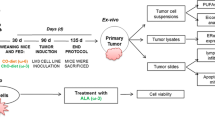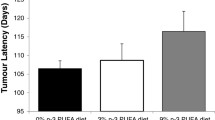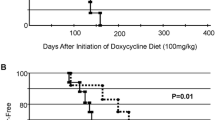Abstract
Breast cancer is one of the common cancers and is a leading cause of cancer mortality in women. The TG.NK transgenic mouse line on FVB strain background expresses the c-neu oncogene under the control of a MMTV promoter in mammary tissue and appears to be a useful animal model for evaluation of strategies to delay or prevent mammary cancer. Fiber-rich nonpurified diet (NTP-2000) and some retinoid analogues have delayed mammary cancer in the TG.NK model. Four week old hemizygous TG.NK female mice with MMTV/c-neu (erbB2) activated oncogene were fed NTP-2000 diet containing the retinoid analogue 4-hydroxyphenylretinamide (4-HPR) at 7 mmol/kg or the arotinoid Ro 40-8757 at 1.5 and 2.5 mmol/kg for 26 weeks. The 4-HPR at 7 mmol/kg diet delayed the development of palpable tumors up to 24 weeks, but by 26 weeks, the incidence markedly increased and was closer to the NTP-2000 diet control group. However, the 4-HPR diet markedly decreased the average weight of the tumors at 26 weeks with no decrease in multiplicity. The 4-HPR also caused significant increase in liver weights without an effect on body weight. Arotinoid Ro 40-8757 caused marked decrease in the number and branching of mammary ducts, and inhibited mammary tumor development with significant decrease in the incidence, multiplicity, and tumor weights compared to the NTP-2000 diet control. Arotinoid also caused a significant dose-related increase in liver weights without a significant effect on body weights. At the doses tested, the arotinoid but not 4-HPR decreased the circulating levels of IGF-1. However, there was no association between the IGF-1 levels and the size, incidence, or absence of tumors when evaluated for any treatment group or for all mice in the study irrespective of treatment. The oncogene erbB2 (c-neu) and the growth factor EGF expression were more prominent in the small tumors of the mice treated with arotinoid than in the larger tumors of the control group. PCNA staining was observed in areas where there was high erbB2 and EGF staining. The delay in onset of mammary tumors by the above retinoid analogues may be related to the delay in development of mammary glands.
Similar content being viewed by others
References
Miller BA, Ries LAG, Hankey BF, Kosary CL, Harras A, Devesa SS, Edwards BK (eds): SEER Cancer Statistics Review: 1973- 1990. National Cancer Institute. NIH Pub No 93- 2789, 1993
Clarke R: Animal models of breast cancer: Their diversity and role in biomedical research. Breast Cancer Res Treat 39: 1–6, 1996
Amundadottir TL, Merlino G, Dickson RB: Transgenic mouse models for breast cancer. Breast Cancer Res Treat 39: 119–135, 1996
Muller WJ, Sinn E, Pattengale PK, Wallace R, Leder P: Singlestep induction of mammary adenocarcinoma in transgenic mice bearing the activated c-neu oncogene. Cell 54: 105–115, 1988
Tennant RW, Rao GN, Russfield A, Seilkop S, Braun AG: Chemical effects in transgenic mice bearing oncogenes expressed in mammary tissue. Carcinogensis 14: 29–35, 1993
Rao GN, Ney E, Herbert RA: Influence of diet on mammary cancer in transgenic mice bearing oncogene expressed in mammary tissue. Breast Cancer Res Treat 45: 149–158, 1997
Moon RC, Mehta RG, Detrisac CJ: Retinoids as chemopreventive agents for breast cancer. Cancer Detect Prev 16: 73–79, 1992
Moon RC, Mehta RG, Rao KVN: Retinoids and cancer in experimental animals. In: Sporn MB, Roberts AB, Goodman DS (eds), The Retinoids. Raven Press, New York, 1994, 2nd edn, pp 573–595
Rao GN, Ney E, Herbert RA: Effect of retinoid analogues on mammary cancer in transgenic mice with c-neu breast cancer oncogene. Breast Cancer Res Treat 48: 265–271, 1998
Hixson EJ, Denine EP: Comparative subacute toxicity of retinyl acetate and three synthetic retinamides in Swiss mice. J Natl Cancer Inst 63: 1359–1364, 1979
Tanaka T, Makita H, Ohnishi M, Mori H, Satoh K, Hara A: Inhibition of oral carcinogenesis by the atotinoid mofarotene (Ro 10-8757) in male F344 rats. Carcinogenesis 16: 1903–1907, 1995
Teelman K, Tsukaguchi T, Klaus M, Eliason JF: Comparison of the therapeutic effects of a new arotinoid Ro 40-8757 and All-trans-and 13-cis-retinoic acids on rat breast cancer. Cancer Res 53: 2319–2325, 1993
Hartmann D, Eliason J, Teelmann K, Kaufmann F, Klaus M: Ro 40-8757: A novel arotinoid with anticancer activity. In: Livera MA, Packer L (eds) Retinoids: Progress in Research and Clinical Application. Marcel Dekker, New York, 1993, pp 491–505
Taketo M, Scroeder AC, Mobraaten LE, Gunning KB, Hanten G, Fox RR, Rodrick TH, Stewart CL, Lilly F, Hansen CT: FVB/N: an inbred mouse strain preferable for transgenic analyses. Proc Natl Acad Sci USA 88: 2065–2069, 1991
Webster MA, Muller WJ: Mammary tumorigenesis and metastasis in transgenic mice. Sem Cancer Biology 5: 69–76, 1994
National Research Council: Guide for the Care and Use of Laboratory Animals. National Academy Press, Washington DC, 1996
Rao GN: New nonpurified diet (NTP-2000) for rodents in the National Toxicology Program's toxicology and carcinogenesis studies. J Nutr 127: 842s–846s, 1997
Rao GN: New diet (NTP-2000) for rats in the National Toxicology Program toxicity and carcinogenecity studies. Fund Appl Toxicol 32: 102–108, 1996
Busby WH, Snyder DK, Clemson DR: Radioimmunoassay of a 26,000-Dalton plasma insulin-like growth factor-binding protein: Control by nutritional variables. J Clin Endocrinol Metab 67: 1225–1230, 1988
Dunn SE, Kari FW, French J, Leininger JR, Travlos G, Wilson R, Barrett JC: Dietary restriction reduces insulin-like growth I levels, which modulates apoptosis, cell proliferation and tumor progression in p53-deficient mice. Cancer Res 57: 4667–4672, 1997
Kenney NJ, Smith GH, Rosenberg K, Cutler ML, Dickson RB: Induction of ductal morphogenesis and lobular hyperplasia by amphiregulin in mouse mammary gland. Cell Growth Diff 7: 1769–1781, 1996
Foley J, Ton T, Maronpot R, Butterworth B, Goldsworthy TL: Comparison of proliferating cell nuclear antigen to tritiated thymidine as a marker of proliferaitng hepatocytes in rats. Environ Health Perspect 101 (Suppl 5): 199–206, 1993
Steel RGD, Torrie JH: Principles and Procedures of Statistics: A Biometrical Approach. 3rd edn, McGraw-Hill, New York, 1997, pp 95–100 and 558
Cox DR, Oakes D: Analysis of Survival Data. Chapman and Hall, New York, 1984, pp 104–107
Hollander M, Wolfe WA: Nonparametric Statistical Methods. Wiley, New York, 1973, pp 68–71 and 185- 194
Koch GG, Atkinson SS, Stokes ME: Poisson regression. In: Kotz S, Johnson NL, Read CB (eds), Encyclopedia of Statistical Sciences, Wiley, New York, 1986, Vol 7, pp 32–41
Lindamood C III, Giles HD, Hill DL: Preliminary toxicity pro-file of arotinoids SMR-2 and SMR-6 in male B6D2F1 mice. Fund Appl Toxicol 8: 517–530, 1987
Valles B, Schiller CD, Coassolo P, De Sousa G, Wyss R, Jaeck D, Viger-Chougnet A, Rahmani R: Metabolism of mofarotene in hepatocytes and liver microsomes from different species. Comparison with in vivo data and evaluation of cytochrome P450 isoenzymes involved in human biotransformation. Drug Metab Dispos 23: 1051–1057, 1995
Medinsky MA, Popp JA, Hamm TE, Dent JG: Development of hepatic lesions in male Fischer-344 rats fed AIN-76A purified diet. Toxicol Appl Pharmacol 62: 111–120, 1982
Abou-Issa H, Webb TE, Minton JP, Moeschberger M: Chemotherapeutic evaluation of glucarate and N-(4-hydroxyphenyl) retinamide alone and in combination in the rat mammary tumor model. J Natl Cancer Inst 81: 1820–1823, 1989
Gudas LJ, Sporn MB, Roberts AB: Cellular biology and biochemistry of the retinoids. In: Sporn MB, Roberts AB, Goodman DS (eds) The Retinoids, Raven Press, New York, 1994, 2nd edn, pp 443–520
Lotan R: Role of retinoids and their nuclear receptors in the development and prevention of upper aerodigestive tract cancers. Environ Health Perspect 105: 985–988, 1997
Kistler A: Structure-activity relationship of retinoids on lobuloalveloar differentiation of cultured mouse mammary glands. Carcinogenesis 7: 1175–1182, 1986
Kazer RR: Insulin resistance, insulin-like growth factor-1 and breast cancer: a hypothesis. Int J Cancer, 62: 403–406, 1995
Friedl A, Jordan VC, Pollak M: Suppression of serum insulinlike growth factor-1 levels in breast cancer patients during adjuvant tamoxifen therapy. Eur J Cancer 29A: 1368–1372, 1993
Pollak MN: Endocrine effects of IGF-1 on normal and transformed breast epithelial cells: potential relevance to strategies for breast cancer treatment and prevention. Breast Cancer Res Treat 49: 209–217, 1998
Schwander JC, Hauri C, Zap FJ, Froesch ER: Synthesis and secretion of insulin-like growth factor and its binding protein by the perfused rat liver: Dependence on growth hormone status. Endocrinol 113: 297–305, 1983
Humbel E: Insulin-like growth factors I and II. Eur J Biochem 190: 445–462, 1990
Rights and permissions
About this article
Cite this article
Rao, G.N., Ney, E. & Herbert, R.A. Changes associated with delay of mammary cancer by retinoid analogues in transgenic mice bearing c-neu oncogene. Breast Cancer Res Treat 58, 239–252 (1999). https://doi.org/10.1023/A:1006315716713
Issue Date:
DOI: https://doi.org/10.1023/A:1006315716713




